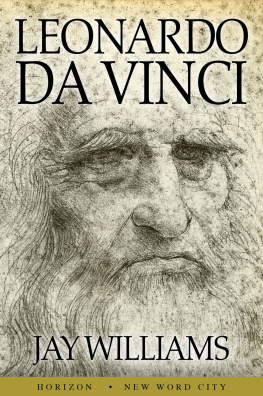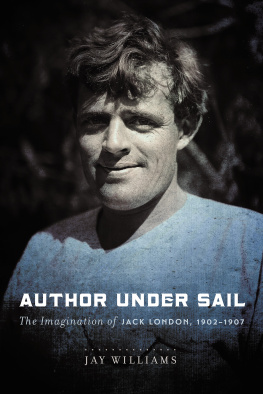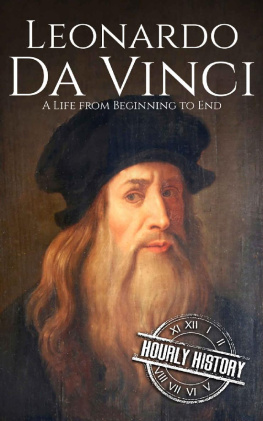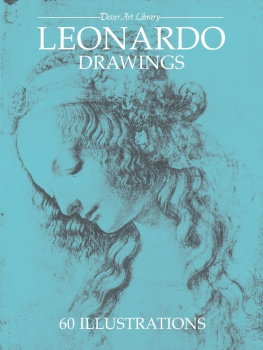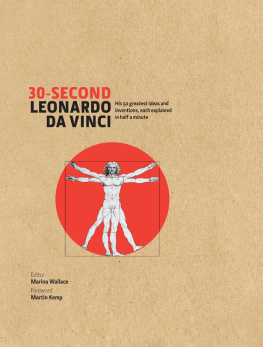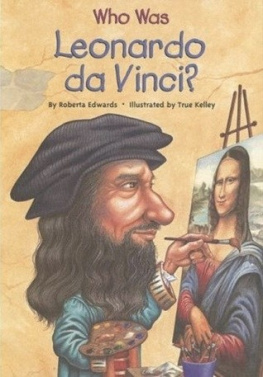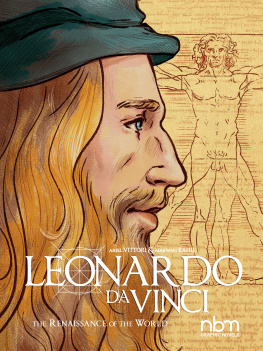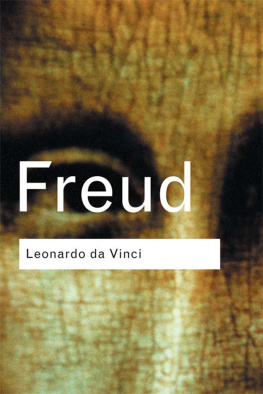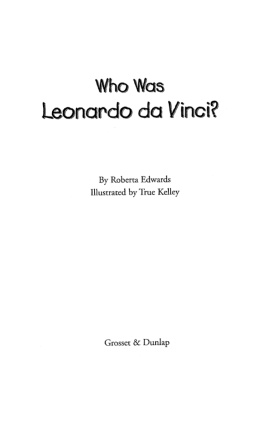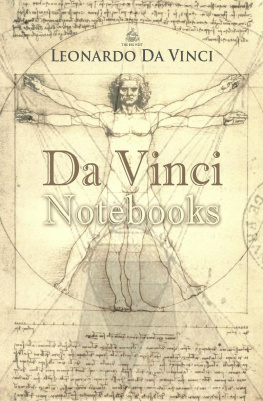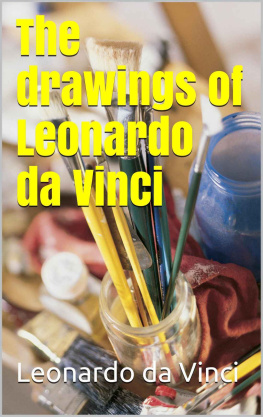Jay Williams - Leonardo da Vinci
Here you can read online Jay Williams - Leonardo da Vinci full text of the book (entire story) in english for free. Download pdf and epub, get meaning, cover and reviews about this ebook. year: 2014, publisher: New Word City, Inc., genre: Non-fiction. Description of the work, (preface) as well as reviews are available. Best literature library LitArk.com created for fans of good reading and offers a wide selection of genres:
Romance novel
Science fiction
Adventure
Detective
Science
History
Home and family
Prose
Art
Politics
Computer
Non-fiction
Religion
Business
Children
Humor
Choose a favorite category and find really read worthwhile books. Enjoy immersion in the world of imagination, feel the emotions of the characters or learn something new for yourself, make an fascinating discovery.
- Book:Leonardo da Vinci
- Author:
- Publisher:New Word City, Inc.
- Genre:
- Year:2014
- Rating:5 / 5
- Favourites:Add to favourites
- Your mark:
- 100
- 1
- 2
- 3
- 4
- 5
Leonardo da Vinci: summary, description and annotation
We offer to read an annotation, description, summary or preface (depends on what the author of the book "Leonardo da Vinci" wrote himself). If you haven't found the necessary information about the book — write in the comments, we will try to find it.
In his youth, Leonardo da Vinci wrote confidently, I wish to work miracles. By the time of his death in 1519, when he was sixty-seven and famed throughout Europe, it seemed that he had accomplished wonders aplenty as an artist, engineer, inventor, and scientist. Here, from author Jay Williams, is the moving story of the man behind the Renaissance myth.
Jay Williams: author's other books
Who wrote Leonardo da Vinci? Find out the surname, the name of the author of the book and a list of all author's works by series.
Leonardo da Vinci — read online for free the complete book (whole text) full work
Below is the text of the book, divided by pages. System saving the place of the last page read, allows you to conveniently read the book "Leonardo da Vinci" online for free, without having to search again every time where you left off. Put a bookmark, and you can go to the page where you finished reading at any time.
Font size:
Interval:
Bookmark:
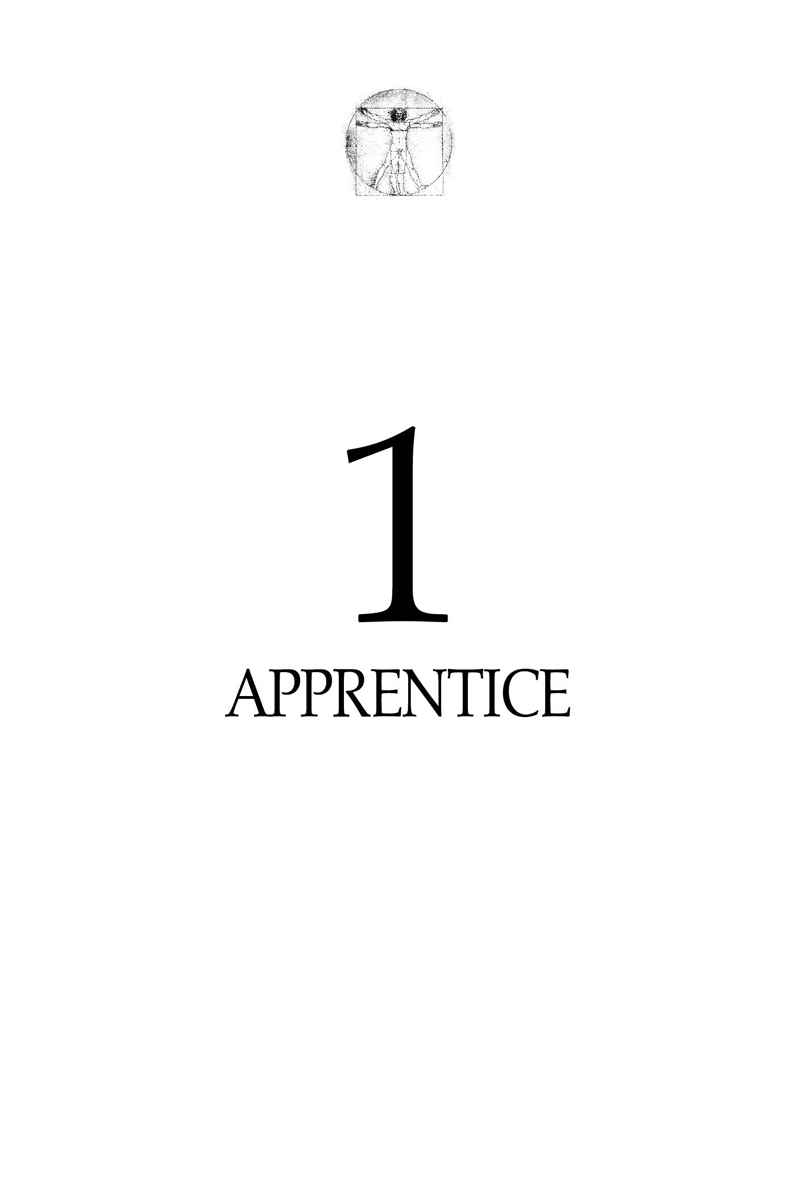
A new spirit dawned over plague-ravaged, war-racked Europe in the fifteenth century. It was like the opening of a vast door, flooding the lands with light. New concepts of freedom were developed. New ways of looking at nature appeared. It seemed that everything was possible, that reason and knowledge would liberate the minds of men and women, that the secrets of the universe would be discovered.
On April 15, 1452, at the height of this age of discovery, Leonardo was born. He was to sum up the restless genius of the time - a painter, inventor, engineer, philosopher, and scientist. To many of his contemporaries, he was a sorcerer, to be admired and feared; his mysterious mind teemed with ideas well ahead of his time. Still, his personality remains, to this day, a puzzle to us.
His beginnings were commonplace, in surroundings that gave little promise for either profound art or thought. He was the son of Piero , a notary from the village of Vinci , near Florence , from which the family took its name. There Piero lived with his father, Antonio, also a notary.
Leonardos mother was a peasant girl named Caterina. Piero was twenty-five when she gave birth to their son and may have proposed marriage. But Antonio had a more suitable match in mind for his reckless son. That same year, he arranged for Piero to marry Albiera di Giovanni Amadori. She was only sixteen. Then, Antonio compelled another man, Accattabriga del Vacca, to take Caterina as his wife. The illegitimate Leonardo spent his early childhood with his mother, in the Tuscan hamlet of Anchiano. Then, at the age of five, he was baptized in the small Vinci church of Santa Croce. He was to be raised by Piero and Albiera.
Pieros small family started out in his fathers country home, where older brother Francesco also lived. Francesco da Vinci was considered lazy since he contributed nothing to the household, but he was an influence on young Leonardo. The uncle and his nephew walked the countryside, exploring the meadows and woods surrounding the village of Vinci on Mount Albano in Tuscany . On one side was the fertile valley of Lucca , with its olive trees, orchards, and farms; on the other, the ragged mountain range where swift streams carved the rocks into odd shapes.
Francesco fed the boys curiosity and love of nature. Lying on their backs in a meadow, the pair marveled at a kite in flight high overhead. Francesco compared the wind-blown object to a majestic bird, always in search of wind to carry it higher. Leonardos imagination was ignited. Later the kite visited him in a dream: In the earliest memory of my infancy it seemed to me that, as I was lying in my cradle, a kite came down to me, and opened my mouth with its tail and struck me many times with its tail between my lips.
These early lessons included trips to a nearby river, which presented a fluid microcosm of life. They studied the metamorphosis of insects and dirtied their hands and knees waiting and watching for sprouts to emerge from the muddy banks. Observing a procession of ants hefting grains of wheat twice their size, the uncle told Leonardo a fable. In it, a grain of wheat made a pact with the ant, promising: Let me go back to the earth, which is my element, and in a years time, I will give you not one, but a hundred grains like me. The ant was skeptical but tired, and it relented. Its faith was rewarded the next year when the grain became an ear of wheat.
Leonardo soaked up this knowledge, but his father, Piero, thought the outings were frivolous. His son needed structure; traipsing through the woods was not an education. One Saturday, Piero returned from a trip to Florence and announced to his father that he was moving his family there. He had rented a house, and Leonardo would attend school in the city. Within a month, they were on their way; as they left, their horse-drawn carriage scattering rocks and dust, Leonardo saw his Uncle Francesco standing in the doorway of their home.
The cacophony of the city soon replaced the calm serenity of the countryside. Florence was rebounding from an economic collapse. Foreign imports of wool and silk had ended a centuries-long monopoly that the citys traders had taken for granted; businesses and banks were forced to close, as a result. A new industry was beginning to emerge: real estate. Land was being snatched up; old buildings were being demolished to make way for new ones. From sunup to sundown, the streets of Florence were filled with the clang of hammers, thuds of axes, and grunts of workmen. The work was more than practical and efficient; the new architecture was splendid and artful.
When Leonardo arrived in Florence, the city was home to the most prominent and prolific artists in Italy, including the sculptor Donatello , the architect Filippo Brunelleschi , and painters such as Filippo Lippi and Benozzo Gozzoli . The citys de facto ruler was Cosimo de Medici . Without holding political office himself, Cosimos vast wealth and ambition gave him extraordinary power over Florences bureaucrats. In the early 1400s, Florence had been involved in struggles between the popes and Holy Roman Em perors and in conflicts with the rival city-states of Italy. It was Cosimo de Medici who led the Florentines to victory over the Viscontis of Milan in the Battle of Anghiari in 1440 and during the uneasy peace that followed.
Cosimo, who made his fortune in banking, used it to promote the arts, architecture, and education. To build his palace, the Palazzo Medici , he hired a young architect and sculptor named Michelozzo Michelozzi . Renowned for its stone masonry, the Palazzo Medici is adorned on each side with gold and marble carvings and sculptures. Cosimos patronage allowed Filippo Brunelleschi, then bankrupt, to complete the dome on the Basilica di Santa Maria del Fiore , Florences most magnificent cathedral.
All of this activity fostered an environment of creativity that intrigued young Leonardo. As he began his formal schooling in Florence, he excelled with such ease that no subject held his interest for long. Quickly, he absorbed all his schoolmaster could teach him; impatiently, he dropped each new subject after mastering its rudiments and went on to the next. In later life, he came to regret this headlong approach.
His father, Piero, had designs on him becoming a notary, like all first-born sons in his family. An energetic, shrewd, and thrifty man, Piero handled the legal business of his neighbors and had numerous friends in Florence. In the streets, many addressed him as Ser, or Master, a mark of respect. He and Albiera were affectionate toward Leonardo, but as their son grew older, he began to feel that he was different from his peers, not only because he was a stepchild but because he was possessed by insatiable curiosity.
As Leonardos mind wandered, so did he. The boy poked his head into artisan shops and studios, mesmerized by paint strokes and the craftsmanship of tools alike. There was no shortage of opportunities for the curious Leonardo to observe art in the making. Though he likely confided in Albiera, Leonardo kept these exploits from his father. He no doubt feared Piero would see them as distractions, as he did all those walks in the woods back in Vinci. Piero took for granted that his sons education was progressing as it should.
Meanwhile, Leonardo began to question and challenge his instructors. The abstract lessons offered in their books were no match for Leonardos own observations, nor the impressions left by his uncle Francesco. Leonardo kept a collection of things that pleased or interested him: snake skins, odd stones polished by water, birds eggs, skeletons of small animals, insects stuck on pins, tadpoles, and unusual plants. He gathered these natural artifacts from the orchards and gardens of Florence. What he could not carry home from his wanderings, he sketched on the spot.
Font size:
Interval:
Bookmark:
Similar books «Leonardo da Vinci»
Look at similar books to Leonardo da Vinci. We have selected literature similar in name and meaning in the hope of providing readers with more options to find new, interesting, not yet read works.
Discussion, reviews of the book Leonardo da Vinci and just readers' own opinions. Leave your comments, write what you think about the work, its meaning or the main characters. Specify what exactly you liked and what you didn't like, and why you think so.

